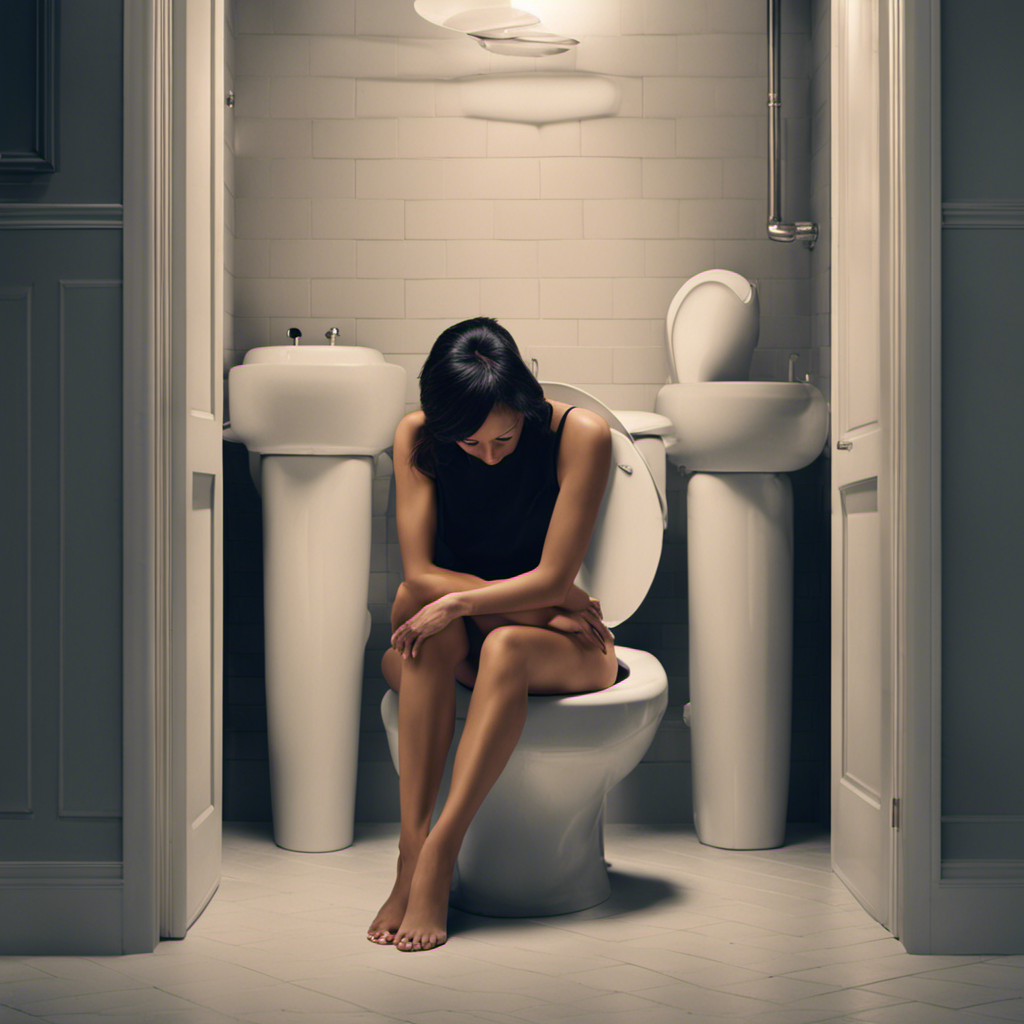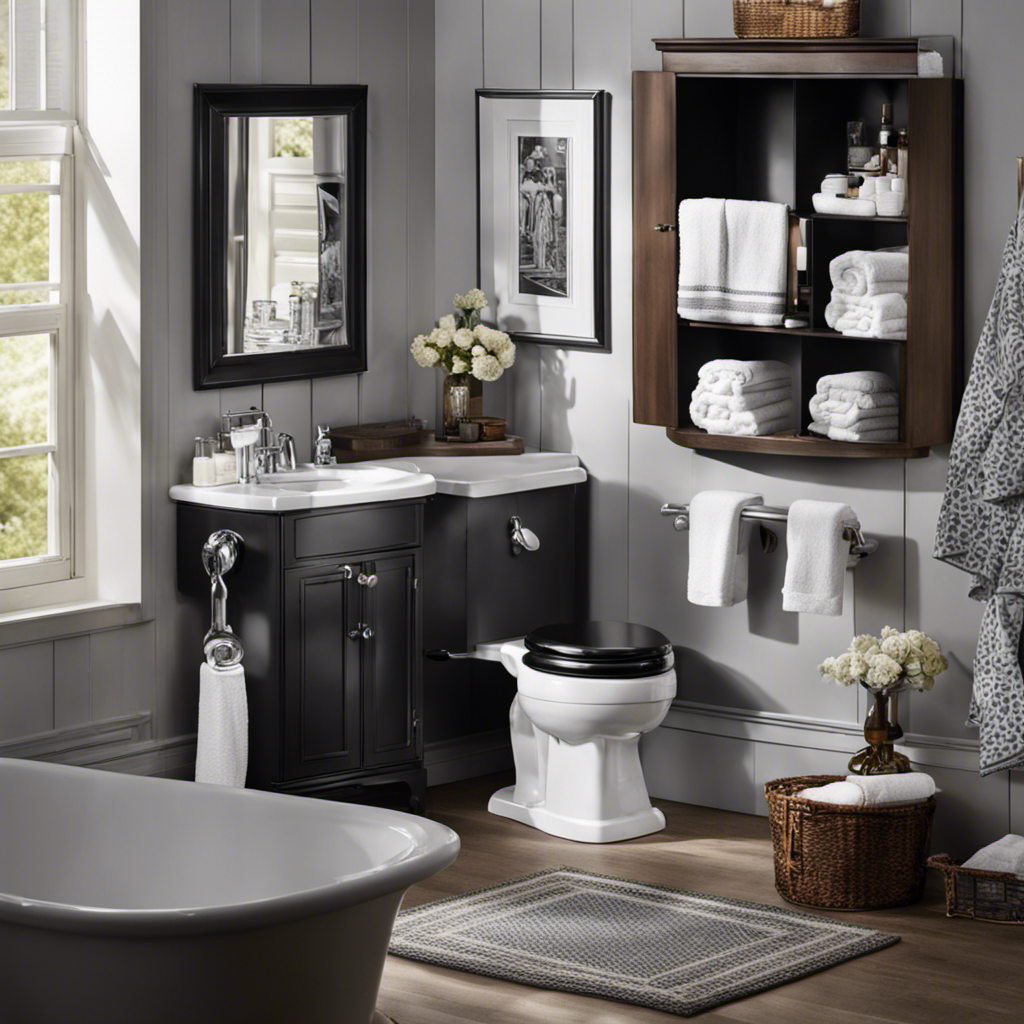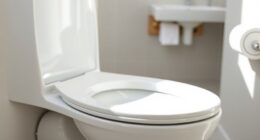As a homeowner, I’ve often wondered, ‘Why does my toilet whistle randomly?’ It’s a perplexing problem that can be both annoying and concerning.
Fortunately, I’ve done some research and discovered the common causes behind this mysterious phenomenon. From water pressure issues to faulty fill valves, mineral buildup to ventilation problems, there are several potential culprits that can lead to a whistling toilet.
In this article, I will delve into the technical aspects of these issues and provide practical solutions to fix a whistling toilet once and for all.
Key Takeaways
- Faulty fill valves can cause irregular water flow and disrupt the water flow into the toilet tank, leading to whistling sounds.
- Water pressure issues, such as high water pressure or low water pressure caused by water softeners, can contribute to toilet whistling.
- Regular maintenance, including checking for leaks and cleaning/replacing the fill valve, is crucial in preventing fill valve issues and toilet whistling.
- Proper ventilation in the plumbing system, achieved through clear and unobstructed vent pipes, is important to prevent whistling sounds in the toilet.
Common Causes of Toilet Whistling
One common cause for your toilet whistling randomly could be a faulty fill valve. The fill valve is responsible for regulating the water level in the toilet tank. If it is not functioning properly, it can lead to issues with water pressure and ventilation.
When the fill valve is faulty, it may not be able to maintain the correct water pressure, resulting in a whistling sound. Troubleshooting water pressure is essential in identifying the root cause of the problem. It is important to check if the water pressure in your home is within the normal range.
Additionally, identifying ventilation problems, such as clogged vents or improper vent installation, can also contribute to toilet whistling. Understanding how water pressure affects toilet whistling is crucial in resolving this issue effectively.
How Water Pressure Affects Toilet Whistling
Water pressure can affect the occurrence of a whistling sound in a toilet. Understanding how water pressure impacts this issue is crucial in finding a solution. Here’s a breakdown of how reducing water pressure and the impact of water softeners can play a role:
-
Reducing water pressure:
High water pressure can cause vibrations in the plumbing system, leading to whistling sounds. Installing a pressure reducing valve can help regulate the water pressure, reducing the chances of whistling. -
Impact of water softeners:
Water softeners remove minerals from the water, which can lead to reduced pressure. Low water pressure caused by water softeners can contribute to the occurrence of toilet whistling.
The Role of Faulty Fill Valves in Toilet Whistling
The role of faulty fill valves in toilet whistling can be significant, as they can cause irregular water flow and lead to unwanted sounds. A faulty fill valve is a common issue in toilet maintenance that can result in a whistling noise.
The fill valve is responsible for controlling the water flow into the toilet tank, ensuring that it fills up to the appropriate level. When the fill valve malfunctions, it may not allow the water to fill properly, causing a disruption in the flow and resulting in a whistle-like sound.
Regular maintenance is crucial in preventing fill valve issues. It is important to check for any leaks, clean the valve, and replace it if necessary. By keeping a close eye on the fill valve, you can avoid the annoyance of a whistling toilet and ensure proper functioning.
Dealing With Mineral Buildup in the Toilet
Dealing with mineral buildup in the toilet is a common maintenance task that homeowners often face. Preventing mineral buildup is crucial to maintaining the proper functioning of the toilet and avoiding potential plumbing issues.
In this discussion, we will explore effective ways to prevent mineral buildup and provide tips for removing stubborn mineral deposits.
Preventing Mineral Buildup
To prevent mineral buildup in your toilet, you should regularly clean it with vinegar or a descaling solution. This will help prevent corrosion and keep your toilet functioning properly.
Here are some steps you can take to prevent mineral buildup:
-
Use a descaling agent: These agents are specifically designed to remove mineral deposits and prevent them from building up. Look for products that contain citric acid or other descaling agents.
-
Regularly clean the toilet bowl: Scrubbing the toilet bowl with a brush and a solution of vinegar and water can help remove any mineral deposits that may be forming.
-
Clean the toilet tank: Mineral buildup can also occur in the toilet tank, so it’s important to clean it regularly as well.
By following these steps, you can prevent mineral buildup in your toilet and keep it functioning smoothly.
In the next section, we will discuss how to remove mineral deposits if they have already formed.
Removing Mineral Deposits
If mineral deposits have already formed in your toilet, you can use a mixture of vinegar and baking soda to help remove them. This combination creates a powerful cleaning solution that can break down the mineral buildup.
Simply pour a cup of vinegar into the toilet bowl and let it sit for a few minutes. Then, add a cup of baking soda and let the mixture fizz. Use a toilet brush to scrub away the deposits, paying extra attention to the areas where the buildup is the most stubborn. Rinse the bowl with water and repeat the process if necessary.
By regularly cleaning your toilet with this vinegar and baking soda mixture, you can prevent mineral deposits from forming and keep your toilet functioning properly.
Now, let’s move on to troubleshooting toilet whistling and addressing ventilation issues in the plumbing system.
Addressing Ventilation Issues in the Plumbing System
Proper ventilation in the plumbing system is crucial to prevent random whistling sounds in your toilet. Here are some ventilation solutions and the importance of regular maintenance:
-
Ventilation Solutions:
-
Ensure that the plumbing vents are clear of any obstructions, such as debris or bird nests.
-
Install or repair the vent pipes to ensure proper airflow and prevent negative pressure.
-
Importance of Regular Maintenance:
-
Regularly inspect the vent pipes for any signs of damage or blockages.
-
Clean the vent pipes to remove any accumulation of dirt or debris.
By addressing ventilation issues and performing regular maintenance, you can eliminate the random whistling sound in your toilet.
However, it’s also essential to consider the impact of loose or damaged toilet parts, which we will discuss in the next section.
The Impact of Loose or Damaged Toilet Parts on Whistling
In my experience as a plumber, I’ve found that a loose flapper can often be the culprit behind the annoying whistling sound coming from a toilet. When the flapper is not properly sealed, it can allow air to escape, causing a whistling noise as the water flows.
Additionally, a damaged fill valve can also contribute to the whistling sound. If the fill valve is damaged, it may not be able to regulate the water flow properly, resulting in a whistling noise.
These two issues, a loose flapper and a damaged fill valve, are common causes of whistling sounds in toilets. It’s important to address these problems promptly to prevent further damage and to restore peace and quiet to your bathroom.
Loose Flapper Causes Whistling
The toilet can whistle randomly when the flapper is loose. This happens because a loose flapper allows air to escape through the flush valve, creating a whistling sound. To better understand the issue, consider the following:
-
Water pressure regulation:
-
High water pressure can exacerbate the whistling sound as it increases the force of water flowing through the loose flapper.
-
Installing a pressure regulator can help regulate the water pressure and reduce the whistling.
-
Toilet flapper replacement:
-
To fix the whistling, you can replace the old flapper with a new one that fits properly, creating a tight seal.
-
Make sure to choose a flapper that is compatible with your toilet model and follow the manufacturer’s instructions for installation.
Damaged Fill Valve Whistles
When it comes to troubleshooting toilet whistling, another common culprit is a damaged fill valve. The fill valve is responsible for regulating the water level in the tank after a flush. If the float mechanism inside the fill valve is damaged, it can cause a whistling sound. This could be due to a worn-out seal or a faulty adjustment.
To determine if the fill valve is the source of the whistling, you can try adjusting the water level in the tank. If the whistling stops or changes pitch when you raise or lower the water level, it’s likely that the fill valve needs to be repaired or replaced.
Now that we’ve identified the possible causes of a whistling toilet, let’s move on to the steps to fixing it.
Steps to Fixing a Whistling Toilet
To fix a whistling toilet, you’ll need to start by checking the water pressure in your home. Here are the steps to fixing a whistling toilet:
-
Check the water pressure:
-
Use a pressure gauge to measure the water pressure in your home.
-
Normal water pressure should be between 40-60 psi.
-
Adjust the water pressure:
-
If the pressure is too high, you may need to install a pressure reducing valve.
-
If the pressure is too low, you may need to adjust the water pressure regulator.
-
Inspect the fill valve:
-
Turn off the water supply and flush the toilet.
-
Remove the fill valve cap and check for any debris or damage.
-
Replace the fill valve:
-
If the fill valve is damaged or old, replace it with a new one.
-
Test the toilet:
-
Turn on the water supply and flush the toilet to check if the whistling has stopped.
Common causes of toilet whistling include high water pressure, damaged fill valves, and debris in the fill valve. By following these steps, you can fix a whistling toilet and restore peace and quiet to your bathroom.
Conclusion
In conclusion, when your toilet whistles randomly, it can be quite unsettling. However, understanding the common causes and implementing the necessary fixes can bring peace back to your bathroom.
Imagine a serene oasis where the water flows smoothly, free from whistling sounds. By addressing issues such as water pressure, faulty fill valves, mineral buildup, ventilation problems, and loose or damaged parts, you can restore harmony to your toilet.
With a little know-how and some handy tools, you can conquer the whistling toilet once and for all.










